20+ Sample Employee Exit Checklist
-
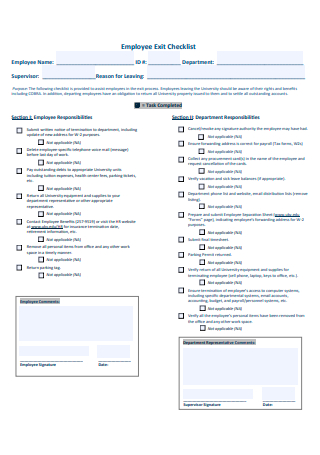
Employee Exit Checklist Template
download now -

Basic Employee Exit Checklist
download now -

Supervisor Employee Exit Checklist
download now -
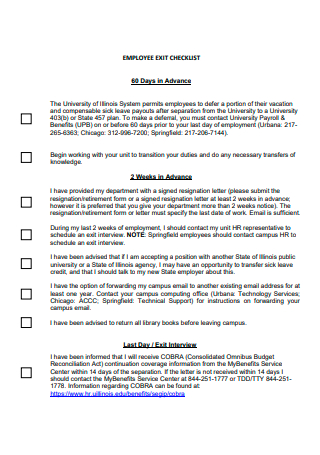
Employee Exit Checklist Example
download now -

Managers Employee Exit Checklist
download now -
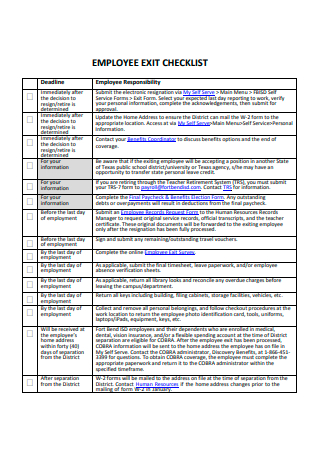
Formal Employee Exit Checklist
download now -
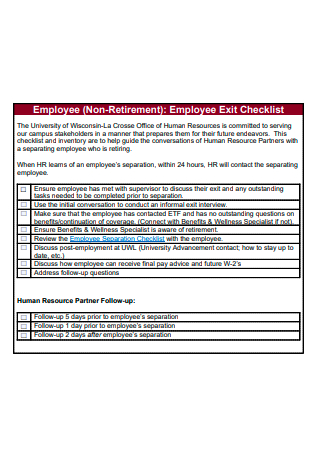
Employee Non-Retirement Exit Checklist
download now -
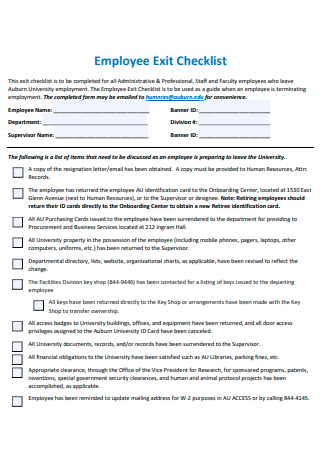
Employee Exit Checklist in PDF
download now -

Employee Records Management Exit Checklist
download now -
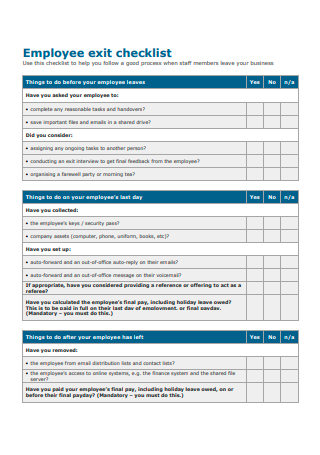
Standard Employee Exit Checklist
download now -
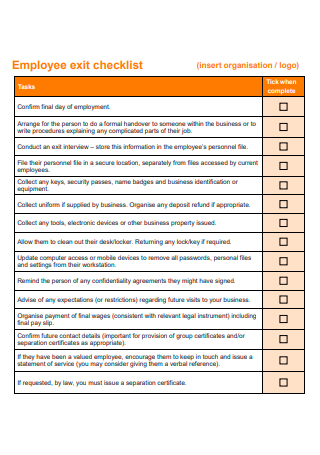
Sample Employee Exit Checklist
download now -
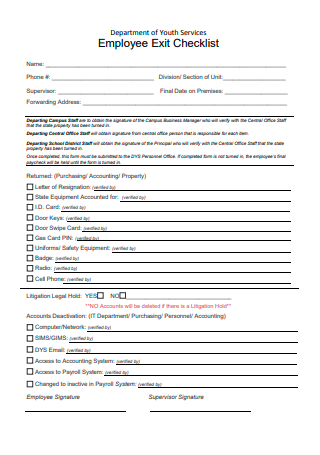
Employee Exit Checklist Format
download now -
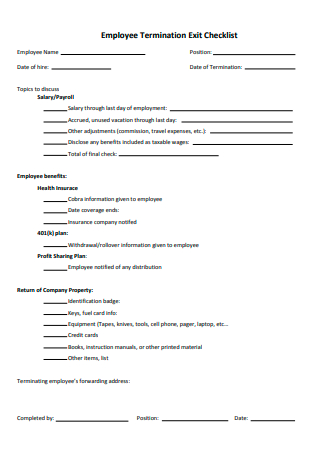
Employee Termination Exit Checklist
download now -

Simple Employee Exit Checklist
download now -
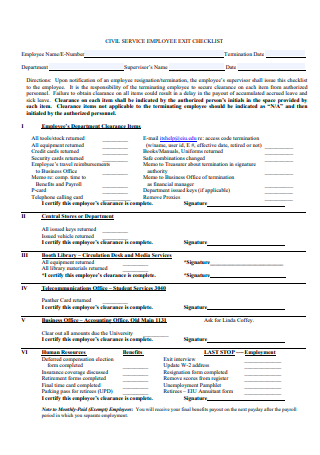
Civil Service Employee Exit Checklist
download now -

Draft Employee Exit Checklist
download now -
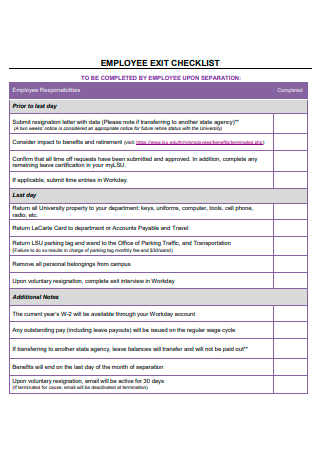
Printable Employee Exit Checklist
download now -
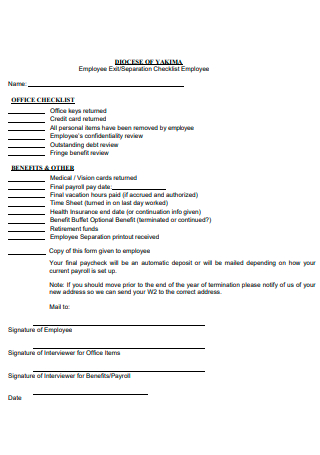
Employee Exit Separation Checklist
download now -
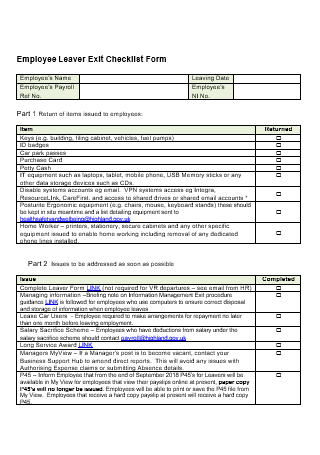
Employee Leaver Exit Checklist Form
download now -

Employee Department Exit Checklist
download now -
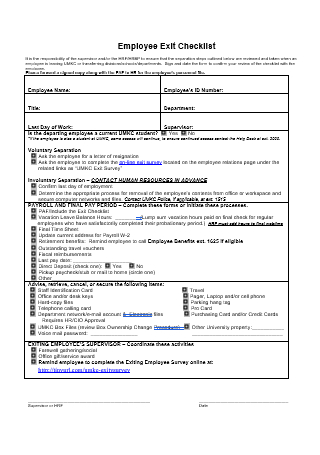
Employee Exit Checklist in DOC
download now
FREE Employee Exit Checklist s to Download
20+ Sample Employee Exit Checklist
What Is an Employee Exit Checklist?
Importance of Exit Interviews
Key Elements of an Employee Exit Plan
How to Write an Employee Exit Checklist
FAQs
Why do companies conduct exit interviews?
What do you say in an exit interview?
Who conducts an exit interview?
What Is an Employee Exit Checklist?
An employee exit checklist outlines all of the actions that must be completed when an employee quits an organization. It is frequently conducted as a check-box activity so that line managers and HR team members can see at a glance which actions have been accomplished and which require additional attention. Preparing the employee leave checklist is a time-consuming procedure that should not be neglected in light of the consequences. Different positions are prone to various degrees of offboarding. However, you must comprehend the standard procedure as well as the specifics of the employee offboarding process, from the moment you receive the resignation letter up to the exit interview.
Importance of Exit Interviews
Employees will leave no matter how amazing your business culture is, how great your training and growth program is, or how great your business leaders are. Whether it’s for a professional change, to care for their newly formed family, or just because it’s time for a change, you won’t be able to keep every employee, especially in this day and age. However, when someone leaves, it is critical to conduct an exit interview to evaluate the whole employee experience and, as a consequence, discover opportunities to increase retention and engagement. This is important for you to be aware of the importance of the employee exit checklist.
Key Elements of an Employee Exit Plan
Another relevant aspect of your employee exit checklist would be an actual employee exit plan. This kind of plan will tackle what you will be doing in the case that your employee decides to take their things and leave the company for their respective reason. You should not focus on it being such a terrible thing because it is a normal process of work. But what you can do is benefit from it and let your company improve. With that being said, this curated list has been made to state what are the elements found in an employee exit plan.
How to Write an Employee Exit Checklist
With two lists made regarding the exit interview and essential parts of an employee exit plan, now is where you can officially proceed to draft out your employee exit checklist. It is important that you fill out each section with ample purpose otherwise, it may not be as relevant in the actual procedure of your employee departing the company. So to better have a grasp, you can view the sample employee exit checklist form which is provided in this article. Think of this as an employee exit checklist guideline to create a concrete list.
1. Communicate the Employee’s Departure
It’s a good idea to coordinate with the employee on when, how, and by whom the specifics of their leave will be revealed to avoid a fragmented spread of knowledge and potentially detrimental workplace gossip. Depending on the circumstances, such as your firm’s culture or the employee’s leaving, you and the individual may pick an official announcement in a company meeting, a more casual email, or even simply mention it in a team huddle. This can be done of course, after the employee sends their official resignation letter to the appointed head of their department or straight away to the HR Manager.
2. Facilitate the Transfer of Knowledge
If you are fortunate enough to have hired a replacement for the leaver’s vacant role prior to their actual departure date, you will undoubtedly benefit from scheduling time for those two individuals to meet to handover outstanding work and for the quitter to coach the succession plan on some of the most critical aspects of the role. This might be a fantastic method to inform the new recruit about aspects of the work that may not be covered in a conventional training course. List out certain responsibilities the resignee has that are important to transfer to the new hire. Otherwise, if you have not found a new hire, then disregard this step.
3. Recover Company Assets
When an employee leaves your organization, you must guarantee that they return any corporate property that was in their control prior to their departure date. This might involve technology like computers and cell phones, as well as other properties such as uniforms or even keys to the premises. It might be beneficial to create a list of these corporate assets in advance to ensure that they have all been recovered. Some examples include but are not limited to receivables, deposit accounts, money orders, checks, bank drafts, marketable securities, and investments.
4. Update IT Access
The IT staff must carry out a process to stop the leaver’s IT access, ensuring that no one else may access their PC or other data after they leave. It’s also customary to include an out-of-office message or automated redirection to the email account before closing it down so that crucial communications from clients don’t go unnoticed. Revoking access to their email or their permission to enter the business office would also need to be done so that no cases will be made regarding that matter.
5. Conduct the Exit Interview
Exit interviews are a necessary step in the employee offboarding process. An exit interview can take the form of a face-to-face chat between the leaver and a member of the HR team, or it can take the form of completing a questionnaire to learn the leaver’s thoughts and opinions about the company, recommendations for change, and genuine reasons for leaving. Smart businesses recognize the need not just to enable an exit interview process, but also to act on the outcomes.
6. Prepare for Future Reference Requests
Your former employee is likely to provide your name and contact information as a referral for any future employment opportunities. Maintain accurate and precise documents pertaining to their employment with you so that you may respond to such inquiries swiftly and appropriately. It goes without saying that you need to answer objectively or give out impartial information regarding your employee’s history with the company.
FAQs
Why do companies conduct exit interviews?
Companies perform departure interviews to learn about employees’ thoughts about their employment, supervisor, organization, and other factors. An exit interview is a dialogue between an employee and their employer, most commonly with the assistance of a human resources person. This is a good time to talk about work happiness or provide comments on policy and direction. Exit interviews can be conducted in person, remotely, or via an exit interview form.
What do you say in an exit interview?
Make sure to express what you loved about working there and what you think they do well. Your employer will likely see your views and experiences as more fair, honest, and factual if you present a balance of good and negative feedback. You want to be truthful in this talk, but you also don’t want to say anything that would make your interviewer look terrible. Practicing what you will say before the interview guarantees that you don’t mispronounce anything or improperly frame an answer. Take a look at this collection of often-asked exit interview questions.
Who conducts an exit interview?
To put the employee at ease and promote honest replies, exit interviews should be performed by an impartial third party, such as a human resources representative. If an exit interview is performed by the immediate supervisor of a departing employee, that individual may be hesitant to be open. This is why sending the resignation letter is often directed toward the HR manager or department head.
There is no standard employee exit checklist format, but if your company utilized one for consistency, then it is better that you use it as well to remain uniform with other employee exit processes. But if your current company lacks one, then that is where you will set your company with their respective job exit checklist.
